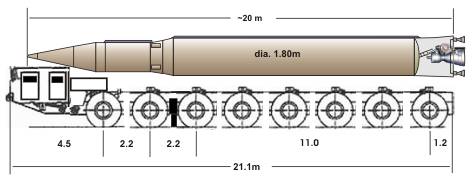|
Analysis:
The HS-14 is a widened variant of the
HS-12 with an added second stage. In this design, North Korea now
has a real operational LRBM.
It replaces the HS-13 project, which was probably discontinued due
to problems with the Soviet 4D10 main engines.
So the speculation that the HS-14 is related to the HS-10 is nonsense.
On the other hand, it is now sure that the HS-14 has a larger
diameter than the HS-12 (1.80m). The diameter of the second stage
is 1.25m. Also sure is that it is a lightweight missile with tank
framework.
The assumption, the first stage of the missile uses the recently
tested engine (one combustor of RD-250) is probably true.
The added steering engines comes from the HS-13 (R-27 origin). The
takeoff thrust is approximately 464 kN. The first stage has reached
an altitude of 585 km after 145sec burn time.
It was reported that the first stage
of the HS-14 during a further launch in July had a longer burn time
of 151 seconds due to increased fuel loading, and reached an altitude
of 703 km.
The second stage is probably equipped with an engine of low thrust
(4D10V?). The burn time of the stage varies between 225 and 235 sec
depending on fuel loading.
The takeoff weight of the HS-14 is estimated at approximately 31 to
32 t.

|